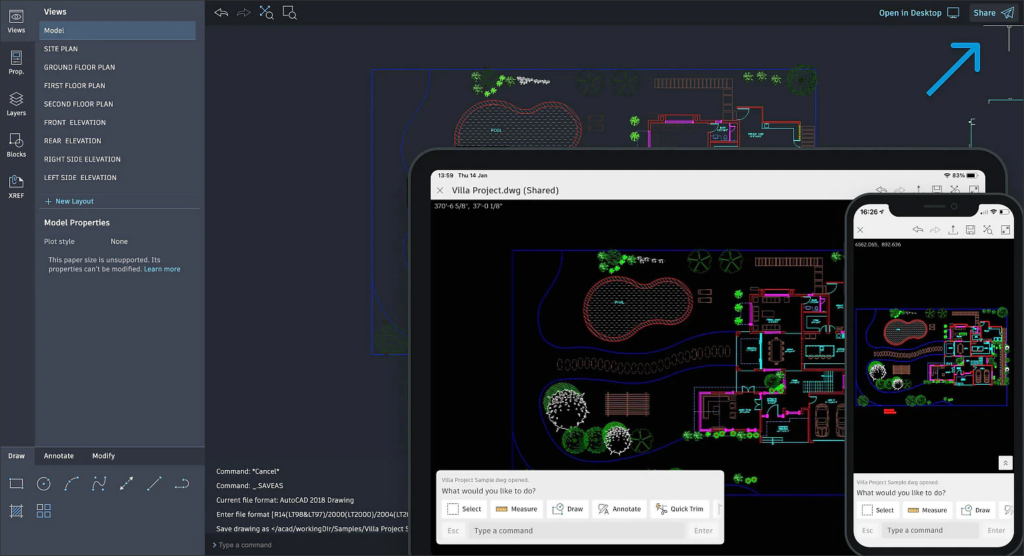Navigating the Design Frontier: Unleashing the Power of AutoCAD Web – Key Features Explored

Introduction:
AutoCAD, the industry-standard computer-aided design (CAD) software developed by Autodesk, has long been synonymous with precision and innovation in the realm of design and drafting. As technology continues to evolve, so does the way designers interact with their tools. AutoCAD Web, a web-based version of AutoCAD, represents a paradigm shift, liberating designers from the constraints of traditional desktop applications. In this comprehensive exploration, we delve into the key features of AutoCAD Web, unraveling the capabilities that empower designers to create, collaborate, and innovate on the go.
AutoCAD Web: A Gateway to Design Anytime, Anywhere
AutoCAD Web extends the reach of AutoCAD beyond the desktop, providing a versatile platform accessible through a web browser. Whether working on a desktop computer, laptop, or tablet, designers can seamlessly transition between devices, ensuring that the creative process remains unhindered by physical boundaries.
- Cross-Platform Accessibility: One of the standout features of AutoCAD Web is its cross-platform accessibility. Designers are no longer tethered to a specific device or operating system. By leveraging the power of a web browser, AutoCAD Web allows users to access their design projects from Windows, macOS, Linux, or even mobile platforms, fostering flexibility and adaptability in the design workflow.
- No Installation Required: AutoCAD Web eliminates the need for intricate software installations. Designers can access the platform directly through a compatible web browser, removing barriers associated with system compatibility or administrative permissions. This feature facilitates a swift and hassle-free onboarding process for users, ensuring they can dive into their design tasks without delay.
- Familiar Interface: AutoCAD Web maintains a user-friendly interface that echoes the familiarity of the desktop version. The ribbon-style toolbar, command line, and navigation tools remain consistent, ensuring that users accustomed to the desktop application can seamlessly transition to the web-based environment without a steep learning curve.
- DWG File Compatibility: AutoCAD Web preserves the integrity of design data by supporting the same DWG file format as its desktop counterpart. This ensures a smooth interchangeability between AutoCAD and AutoCAD Web, allowing designers to collaborate seamlessly across platforms and devices without worrying about data loss or format conversions.
- Collaboration in Real-Time: The collaborative nature of AutoCAD Web sets it apart. Multiple users can work on the same drawing simultaneously, with changes reflected in real-time. This feature facilitates efficient collaboration among team members, whether they are in the same office or dispersed across different geographical locations.
- Cloud Storage Integration: AutoCAD Web seamlessly integrates with cloud storage solutions, enabling designers to access their projects from various devices without the need for manual file transfers. The integration with Autodesk Drive ensures that design files are securely stored in the cloud, providing a centralized and easily accessible repository.
Key Features Explored:
Now, let’s delve into the key features that make AutoCAD Web a powerful and versatile tool for designers on the move:
- Drafting and Editing Tools: AutoCAD Web offers a robust set of drafting and editing tools, empowering designers to create precise and detailed drawings. From basic shapes to intricate geometries, the platform supports a range of drawing elements. The familiar array of editing commands allows users to modify, trim, and extend elements with ease.
- Layer Management: Layer management is a crucial aspect of design, and AutoCAD Web ensures that users can organize and control the visibility of drawing elements through an intuitive layer management interface. Designers can easily toggle layer visibility, change layer properties, and maintain a structured drawing environment.
- Annotation and Text Tools: AutoCAD Web supports annotation and text tools, enabling designers to add textual information to their drawings. From dimensions and labels to detailed annotations, the platform provides a range of options to communicate design intent clearly.
- Measurement Tools: Precise measurement is fundamental in design, and AutoCAD Web offers an assortment of measurement tools to ensure accuracy. Designers can measure distances, angles, and areas with ease, aiding in the evaluation and validation of design dimensions.
- View and Visualization Tools: AutoCAD Web provides powerful visualization tools that allow designers to manipulate the view of their 3D models. Pan, zoom, and orbit controls offer a dynamic perspective, while the realistic rendering option provides an enhanced visualization of the final design.
- PDF Export and Printing: Designers can export their AutoCAD Web drawings to PDF format directly from the platform, facilitating easy sharing and distribution. Additionally, the ability to print directly from the web interface ensures that users can produce hard copies of their designs with minimal effort.
- Version History and Undo/Redo: AutoCAD Web includes version history functionality, enabling designers to track changes made to a drawing over time. The platform also supports robust undo and redo capabilities, providing users with the flexibility to experiment with design iterations and revert to previous states if needed.
- Integration with AutoCAD Mobile: AutoCAD Web seamlessly integrates with AutoCAD Mobile, extending the design workflow to mobile devices. Designers can access their drawings on the go, make annotations, and collaborate with team members from their smartphones or tablets, enhancing productivity and flexibility.
Security and Data Integrity:
Security is a paramount concern in the digital realm, especially when dealing with sensitive design data. AutoCAD Web addresses this concern with robust security measures, ensuring that data is encrypted during transmission and storage. Authentication protocols and access controls further safeguard design files, providing users with peace of mind regarding the confidentiality and integrity of their work.
Conclusion:
In conclusion, AutoCAD Web emerges as a transformative addition to Autodesk’s suite of design tools, transcending the boundaries of traditional CAD applications. The cross-platform accessibility, real-time collaboration, and seamless integration with cloud storage underscore AutoCAD Web’s commitment to empowering designers with flexibility, efficiency, and accessibility. As technology continues to shape the landscape of design, AutoCAD Web stands at the forefront, offering a dynamic and collaborative platform that mirrors the evolution of design workflows. Whether in the office, at home, or on the go, designers can harness the power of AutoCAD Web to navigate the design frontier, bringing their creative visions to life with unprecedented ease and connectivity.







